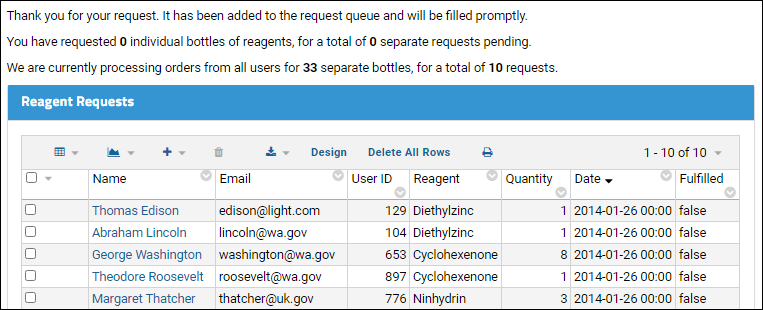, you are ready to create the confirmation page. This page will display the count of requests made by the current user, followed by a grid view of requests submitted by all users, similar to the following. You can sort and filter the grid to see specific subsets of requests, such as your own.
After you have submitted one or more "requests" the tallies will change and your new requests will be shown.
.
is used to calculate total reagent requests and total quantities of reagents for the current user and for all users. These totals are output to text on the page to provide the user with some idea of the length of the queue for reagents.
) is used to calculate the number of rows in the data table returned by LABKEY.Query.executeSql. It is used instead of the rowCount property because rowCount returns only the number of rows that appear in one page of a long dataset, not the total number of rows on all pages.
<p>Thank you for your request. It has been added to the request queue and will be filled promptly.</p>
<div id="totalRequests"></div>
<div id="allRequestsDiv"></div>
<div id="queryDiv1"></div>
<script type="text/javascript" nonce="<%=scriptNonce%>">
window.onload = init();
function init() {
var qwp1 = new LABKEY.QueryWebPart({
renderTo: 'queryDiv1',
title: 'Reagent Requests',
schemaName: 'lists',
queryName: 'Reagent Requests',
buttonBarPosition: 'top',
// Uncomment below to filter the query to the current user's requests.
// filters: [ LABKEY.Filter.create('UserID', LABKEY.Security.currentUser.id)],
sort: '-Date'
});
// Extract a table of UserID, TotalRequests and TotalQuantity from Reagent Requests list.
LABKEY.Query.executeSql({
schemaName: 'lists',
queryName: 'Reagent Requests',
sql: 'SELECT "Reagent Requests".UserID AS UserID, ' +
'Count("Reagent Requests".UserID) AS TotalRequests, ' +
'Sum("Reagent Requests".Quantity) AS TotalQuantity ' +
'FROM "Reagent Requests" Group BY "Reagent Requests".UserID',
success: writeTotals
});
}
// Use the data object returned by a successful call to LABKEY.Query.executeSQL to
// display total requests and total quantities in-line in text on the page.
function writeTotals(data)
{
var rows = data.rows;
// Find overall totals for all user requests and quantities by summing
// these columns in the sql data table.
var totalRequests = 0;
var totalQuantity = 0;
for(var i = 0; i < rows.length; i++) {
totalRequests += rows[i].TotalRequests;
totalQuantity += rows[i].TotalQuantity;
}
// Find the individual user's total requests and quantities by looking
// up the user's id in the sql data table and reading off the data in the row.
var userTotalRequests = 0;
var userTotalQuantity = 0;
for(i = 0; i < rows.length; i++) {
if (rows[i].UserID === LABKEY.Security.currentUser.id){
userTotalRequests = rows[i].TotalRequests;
userTotalQuantity = rows[i].TotalQuantity;
break;
}
}
document.getElementById('totalRequests').innerHTML = '<p>You have requested <strong>' +
userTotalQuantity + '</strong> individual bottles of reagents, for a total of <strong>'
+ userTotalRequests + '</strong> separate requests pending. </p><p> We are currently '
+ 'processing orders from all users for <strong>' + totalQuantity
+ '</strong> separate bottles, for a total of <strong>' + totalRequests
+ '</strong> requests.</p>';
}
</script>
 After you have submitted one or more "requests" the tallies will change and your new requests will be shown.See a live example.
After you have submitted one or more "requests" the tallies will change and your new requests will be shown.See a live example.